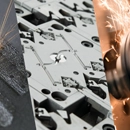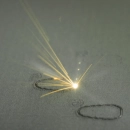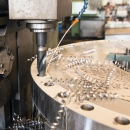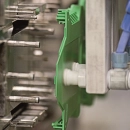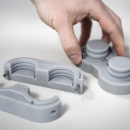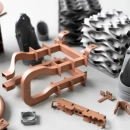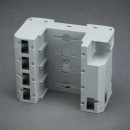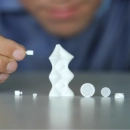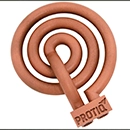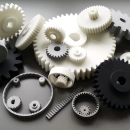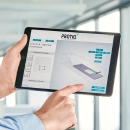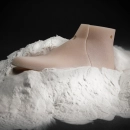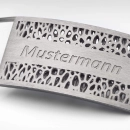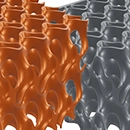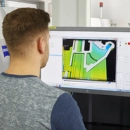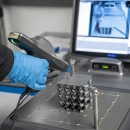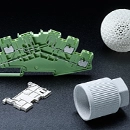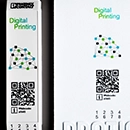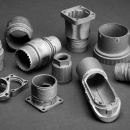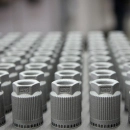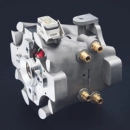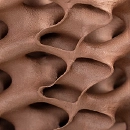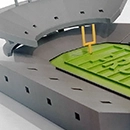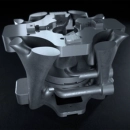PA11 ESD in 3D printing
What is ESD?
Electrostatic discharges (ESD) are sudden voltage surges caused by large potential differences between two objects. A high electric current flows for a brief moment. Such discharges can also occur in everyday life, for example as a noticeable shock when touching a door handle after walking across a carpet.
In industrial contexts, however, ESD events are by no means harmless: they can ignite flammable atmospheres and, above all, damage sensitive electronic components. Even discharges below the human perception threshold can irreversibly destroy semiconductor components, for example. Modern microelectronics in particular are extremely sensitive to ESD-related overvoltages. This is why ESD protection plays a crucial role in electronics production, but also in other industries, such as the chemical industry or painting processes with explosion hazards.
Why are ESD materials needed?
Conventional plastics have an insulating effect and can hardly dissipate electrical charges. Such insulating materials have a very high surface resistance (typically over 10¹² Ω), which means that electrons cannot move freely - instead, charge accumulates on the surface. A person or an object made of insulating plastic can become highly statically charged as a result; when suddenly discharged (e.g. by touching an earthed object), the undesirable ESD then occurs.
Although purely conductive materials (such as metals) do not offer any scope for static charging (surface resistance usually below 10³ Ω), they do pose other risks, such as short circuits in electrical devices if the material is in direct contact with live components.
A compromise is therefore needed: dissipative materials. These materials have a surface resistance in the range of around 10⁶ to 10⁹ Ω and are considered the "golden mean". Charge carriers can move in this range, but in a controlled manner and slowly enough not to cause sudden discharges. A static charge is thus continuously discharged without high potential differences occurring - the component remains ESD-safe.
Such materials are rarely found in nature and must be specifically adjusted by combining insulating plastics with conductive fillers. Typical fillers are carbon fibers or carbon black particles, for example, which give the plastic a defined electrical conductivity without making it metallically conductive. ESD materials must therefore have a precisely tuned electrical resistance that dissipates charges but does not endanger sensitive electronics through short circuits. In addition, they should be robust, durable and process reliable, for example for housings, brackets or tools in industrial environments.
Need the most important information about the PA11 ESD at a glance?
Then simply download our free flyer:
Properties and special features
Polyamide 11 (PA11) is an engineering plastic from the nylon family. It is characterized by good mechanical properties, high resistance to chemicals and pronounced toughness. Unlike the widely used PA12, PA11 is made from renewable raw materials: It is based on castor oil, from which the monomer 11-aminoundecanoic acid is obtained by chemical synthesis. The material is naturally somewhat more flexible and impact resistant than PA12, has comparable strength and is widely used in 3D printing for functional components.
PA11 ESD is a specially developed variant of this plastic with ESD-capable properties. The addition of conductive particles gives the PA11 powder a defined electrical conductivity, which can also be recognized by the typical grey colouring. The additively manufactured components can therefore reliably dissipate unwanted electrostatic charges and effectively protect sensitive components from ESD damage.
In addition to its electrical properties, PA11 ESD also impresses with its mechanical and thermal performance. The material achieves a tensile strength of up to 55 MPa with a high elongation at break of up to 31%. As a result, the 3D-printed components are both strong and tough and can easily withstand the mechanical stresses of everyday industrial use.
Advantages of PA11 ESD at a glance
- ESD-safe: Dissipative material with defined electrical conductivity - protects sensitive electronics from electrostatic discharge.
- Mechanically resilient: High tensile strength and elongation at break - ideal for functional components subject to structural stress.
- Additive processable: Perfect for laser sintering (SLS) - complex geometries, no tooling costs, fast implementation.
- Suitable for EPA zones: Can be used in ESD protection zones (Electrostatic Protected Areas) thanks to surface resistance in the dissipative range.
- Design without compromise: Customized solutions for fixtures, housings or carriers - from single pieces to small series.
PA11 ESD thus combines several advantages: reliable ESD protection, high mechanical performance and the use of a bio-based raw material - a rare and valuable combination for many industries.
Ideal areas of application for 3D printing with PA11 ESD
Components made of PA11 ESD are used wherever sensitive electronics need to be protected from static discharges or where only dissipative equipment is permitted in ESD protection zones. Electronic housings are a classic example: circuit boards, semiconductors and sensors can be operated safely in a housing made of PA11 ESD, as the material does not accumulate any charge and dissipates any static charges to the outside in a controlled manner. This is particularly advantageous in measuring devices, control housings or computer hardware. Such housings also benefit from the mechanical robustness of the material: it not only protects the electronics from ESD, but also from external influences.
PA11 ESD is also used to additively manufacture a wide range of assembly devices and workpiece carriers for electronics production. In production lines, for example, component carriers, holders or brackets often need to be ESD-safe so that sensitive components are not damaged by static discharges during assembly, transportation or testing processes. 3D printing with PA11 ESD is ideally suited for such applications, as it allows precise solutions for specific workpieces to be realized efficiently. Sensor holders or grippers for automation systems can also be made from this material: Its conductivity ensures the safe operation of electronic sensors in the machine environment.
Customer-specific tools made from PA11 ESD have also proven themselves in industrial practice, such as antistatic screwdriver holders, test equipment or measuring device housings that are used in ESD-protected areas. Last but not least, the material is also used in wear-resistant machine accessories, for example in covers or guides, where high mechanical strength is required in addition to ESD protection.
Detailed material data: PA11 ESD
General properties
|
Properties |
Unit |
Value |
|
Laser-melted density |
g/cm³ |
1,07 |
|
Roughness after sandblasting (Ra/Rz) |
µm |
6–10 / 35–45 |
|
mm |
+/- 0,7 %, min. 0,1 mm |
|
|
Minimum wall thickness |
mm |
1,0 |
|
Properties |
Unit |
Value |
|
Specific contact resistance |
Ω*cm |
2,3 * 106 (x); 2,1 * 105 (z) |
|
Surface resistance |
Ω |
1,3 * 104 (x); 3,4 * 104 (z) |
Mechanical properties
|
Properties |
Unit |
Value |
|
Flexural modulus |
MPa |
1.650 – 2550 |
|
Tensile modulus |
MPa |
1.550 – 2300 |
|
Tensile strength |
MPa |
47 – 55 |
|
Elongation at break |
% |
22 – 31 |
|
Izod impact strength |
kJ/m² |
81 – 83 |
|
Izod notched impact strength |
kJ/m² |
5,5 – 7,9 |
|
Charpy notched impact strength |
kJ/m² |
5,3 – 7,3 |
|
Charpy impact strength |
kJ/m² |
101 – 107 |
FAQ: Frequently asked questions about PA11 ESD in 3D printing
What does ESD mean and why is it relevant in production?
ESD stands for "Electrostatic Discharge". It occurs when an electrical charge between two objects suddenly equalizes - for example, when touching an earthed object after static electricity has built up. In industrial production, ESD can destroy sensitive electronic components or ignite explosive atmospheres. This is why protection against ESD is essential in many industries such as electronics, automation, chemicals and medical technology.
What is PA11 ESD?
PA11 ESD is a polyamide 11 modified with conductive additives that has been specially developed for ESD protection. The material combines the mechanical advantages of PA11 with defined electrical conductivity. Manufactured with additives - e.g. using the laser sintering process - PA11 ESD reliably dissipates static charges and thus protects sensitive components from damage caused by electrostatic discharge.
Is there an official data sheet for PA11 ESD?
Yes, all technical data on the mechanical, thermal and electrical properties of PA11 ESD can be found in the official data sheet: Material data sheet PA11 ESD
Which process is used to process PA11 ESD in 3D printing?
At PROTIQ, PA11 ESD is processed using selective laser sintering (SLS) - a powder-based 3D printing process in which thin layers of plastic powder are melted layer by layer using a laser. This process is ideal for processing PA11 ESD, as it enables high dimensional accuracy, good reproducibility and complex, support-free geometries. At the same time, the SLS process enables the cost-effective production of individual parts through to small batches without tooling costs.
Why is PA11 ESD particularly suitable for industrial 3D printing?
PA11 ESD can be processed precisely and repeatably using selective laser sintering (SLS). It enables the production of functional, mechanically resilient components with an integrated ESD protection function - without tooling costs. 3D printing with PA11 ESD really comes into its own with prototypes, small series and complex geometries.
In which applications is PA11 ESD typically used?
Typical applications include electronic housings, workpiece carriers, assembly devices, sensor holders, test equipment, machine covers or components in explosion-protected areas.



 Deutsch
Deutsch English
English